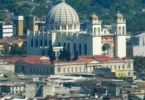
Introduction
The Shrine of Our Lady of Lebanon is a Marian shrine and a pilgrimage site in the village of Harissa in Lebanon. The shrine is under the authority of the Maronite Patriarchate and has been entrusted to the Congregation of Maronite Lebanese Missionaries since its establishment in 1904. Additionally, it has been overseen by Jesuit Lucien Cattin, according to Christian Taoutel, a historian from the Saint Joseph University in Lebanon. It stands as one of the world’s foremost shrines dedicated to Mary, the Mother of Jesus. Central to the shrine is a colossal 15-ton bronze statue of the Virgin Mary, towering at 8.5 meters in height with a diameter of five meters, her outstretched hands reaching towards Beirut.
The Shrine of Our Lady of Lebanon attracts millions of faithful followers, including Christians and Muslims, from across the globe. In 1954, the 50th jubilee coincided with the centennial anniversary of the establishment of the Catholic dogma of the Immaculate Conception. During this commemoration, Pope Pius XII dispatched Cardinal Angelo Roncalli (later Pope John XXIII) as his envoy to Lebanon, while Pope John Paul II paid a visit to Our Lady of Lebanon in 1997.
The Congregation of Maronite Lebanese Missionaries, responsible for the shrine’s administration, endeavors to foster unity among local Churches, Christian communities, and apostolic movements.
Mary, the Mother of Jesus, holds a special place in the hearts of Lebanese Christians, as well as among the Druze and Muslims. In 1908, upon the shrine’s completion, the Maronite Patriarch of Antioch bestowed upon her the title of “Queen of Lebanon.” Situated above the bay of Jounieh, the shrine has emerged as a prominent tourist destination, with visitors often utilizing the Téléphérique gondola lift from the city of Jounieh to reach Harissa.

In 1907, a 13-ton bronze statue of the Virgin Mary, crafted in France and painted white, was erected on a hilltop in the village of Harissa, standing 650 meters above sea level. Comprising seven sections assembled atop a stone base, the statue’s base measures 64 meters at the bottom and 12 meters at the top, with an overall height of 20 meters. The statue itself stands at 8.50 meters tall with a perimeter of 5.50 meters. Inaugurated alongside the shrine in 1908, it has since become a significant pilgrimage site in Lebanon.
Within the base of the statue lies a small chapel, while nearby stands a modernistic Maronite cathedral constructed of concrete and glass. Dedicated to Our Lady of Lebanon, more than 60 churches, schools, and shrines worldwide bear this dedication.
Adjacent to the statue lies the Byzantine-style Melkite Greek Catholic basilica of St. Paul, constructed between 1948 and 1998. The area surrounding Harissa and Our Lady of Lebanon also houses the Apostolic Nunciature and the residences of four patriarchs of Eastern Catholic Churches.
Nestled amidst a pine forest, offering a breathtaking view of the Bay of Jounieh, the sanctuary of Our Lady of Lebanon is renowned for its scenic location. Classified as one of Lebanon’s most beautiful tourist sites by the Ministry of Tourism, it attracts visitors from both Arab and foreign locales.
On May 10, 1997, Pope John Paul II paid a visit to Harissa, followed by Pope Benedict XVI’s visit on September 15, 2012, which included a stop at Our Lady of Lebanon.

Pope John Paul II made an official visit to Lebanon on May 10, 1997, during which he visited the shrine and conducted a mass in the modern Basilica. Later, on December 8, 1998, the Vatican announced that the World Day of the Sick would be observed on February 11, 1999, at Our Lady of Lebanon in Harissa. During this event, Pope John Paul II prayed for the intercession of Our Lady of Lebanon, asking for her assistance for all those who were suffering worldwide.
In a similar vein, Pope Benedict XVI appealed for peace in Lebanon and Gaza on January 28, 2007, invoking the protection of Our Lady of Lebanon. He urged Christians in Lebanon to actively promote dialogue among various communities and sought the protection of Our Lady of Lebanon for all.
It is worth noting that the Apostolic Nuncio to Lebanon and the residences of four Eastern Catholic Churches patriarchs are situated in the vicinity of the shrine of Our Lady of Lebanon.
Harissa Park
In 1908, the dream of Patriarch Elias Howayek saw the light; a Sanctuary on the name of the Virgin Mary, Our Lady of Lebanon, was launched on one of the most beautiful hills of our homeland to embrace her children of all sects and creeds.
Besides the spiritual, pastoral and social services provided by the Shrine, the administration decided to add this year, tourism and heritage park to welcome:
Families, where they find a familial restaurant with a wide outdoor playground for their kids.
Individuals and groups, to enjoy the calm and relaxed atmosphere redolent within a wide variety of trees and flowers.
Annual Feast Day
Feast Date : 1st Sunday of May
The annual feast day of Shrine of Our Lady of Lebanon, Harissa,, is celebrated 1st Sunday of May every year.
Mass Timing
Weekly Masses
Monday to Friday : 7:00 am, 9:00 am & 6:00 pm
Weekend Masses
Saturday : 7:30am & 6:00 Pm
Sundays : 9:30 am, 11:00 am, 5:00 pm, 7:00 pm
Church Visiting Hours
Monday to Sunday : 7:00am to 9:00pm
Contact Info
XMJ2+MG8,
Harissa,
Lebanon.
Phone No.
Phone: +961 9 263 660
Accomodations
Connectivities
Airway
The nearest Domastic airport to the Shrine of Our Lady of Lebanon, Harissa, is Dekwene airport -. which is 25.2 km away from the Shrine.







